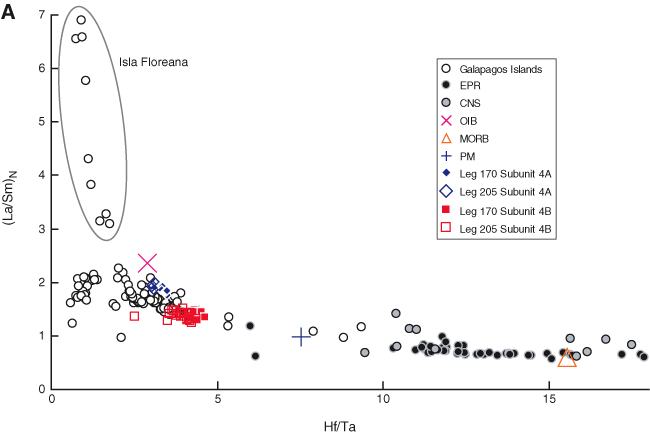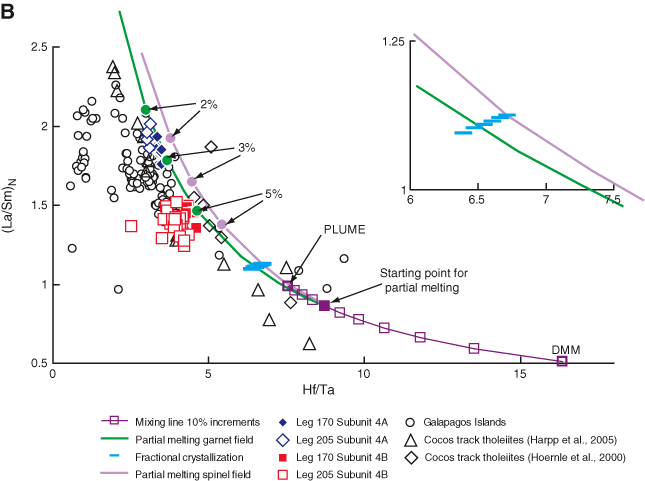
Figure F11. A. (La/Sm)N vs. Hf/Ta for Subunits 4A and 4B. Also shown are East Pacific Rise (EPR) basaltic glasses (5°–15°N) and Cocos-Nazca spreading center (CNS) and Galápagos Islands basalts extracted from published geochemical data (GEOROC and PetDB Web sites). Samples from the CNS and EPR generally have Hf/Ta >10 with (La/Sm)N ~0.5–1. Galápagos Island data have Hf/Ta <5, as do Subunits 4A and 4B, with (La/Sm)N = ~1–2.5. The highest (La/Sm)N values of the Galápagos Islands are from the anomalous "main series" of Isla Floreana, thought to be related to partial melting of an ITE-rich source distinct from the other islands in the Galápagos (Bow and Geist, 1992; Harpp and White, 2001). Averages of oceanic island basalt (OIB), mid-ocean-ridge basalt (MORB), and primitive mantle (PM) are from Sun and McDonough (1989). Includes data from Kimura, Silver, Blum, et al. (1997). Also shown are data from Leg 206, the fast-spreading East Pacific Rise deep reference site (Wilson, Teagle, Acton, et al., 2003). For clarity, Cocos track tholeiites are not shown. B. (La/Sm)N vs. Hf/Ta illustrating the relative importance of binary mixing, partial melting, and fractional crystallization. Batch melting trajectories are shown for a hybrid composition that is 60% enriched. Numbers next to partial melting curves represent percentage of partial melt. The pathway differences in marking the garnet and spinel fields are negligible, but the degrees of melting vary slightly along a given path. Inset shows the effect of 50% fractional crystallization that is minor and has a trend distinct from that of partial melting. Liquid lines of descent trend towards lower (La/Sm)N and Hf/Ta because of the lower bulk incompatibilities of La and Hf compared to Sm and Ta, respectively. Includes data from Kimura, Silver, Blum, et al. (1997). Also shown are data from Leg 206, the fast-spreading East Pacific Rise deep reference site (Wilson, Teagle, Acton, et al., 2003). Batch melting modes of peridotite following Kinzler (1997): olivine = 53%, orthopyroxene = 27%, clinopyroxene = 17%, and Al-phase (garnet or spinel) = 3%: CL = CO/[D + F(1 – D)], where CL is the concentration of the liquid, CO is the concentration of the original solid, F is the fraction of melt produced, and D is the bulk distribution coefficient of the original solid. Fractional crystallization modes approximate volume percent phenocrysts in samples (Kimura, Silver, Blum et al., 1997): CL = COF(D – 1), where CL is concentration residual liquid and F is the fraction of melt remaining. Partition coefficient data from McKenzie and O'Nions (1991) except plagioclase-Hf from Villemant et al. (1981).




![]()